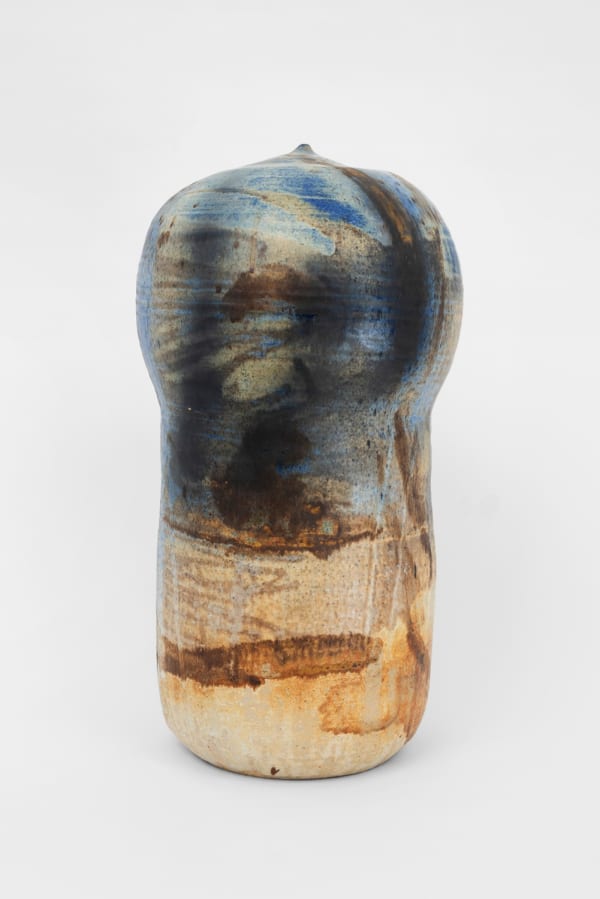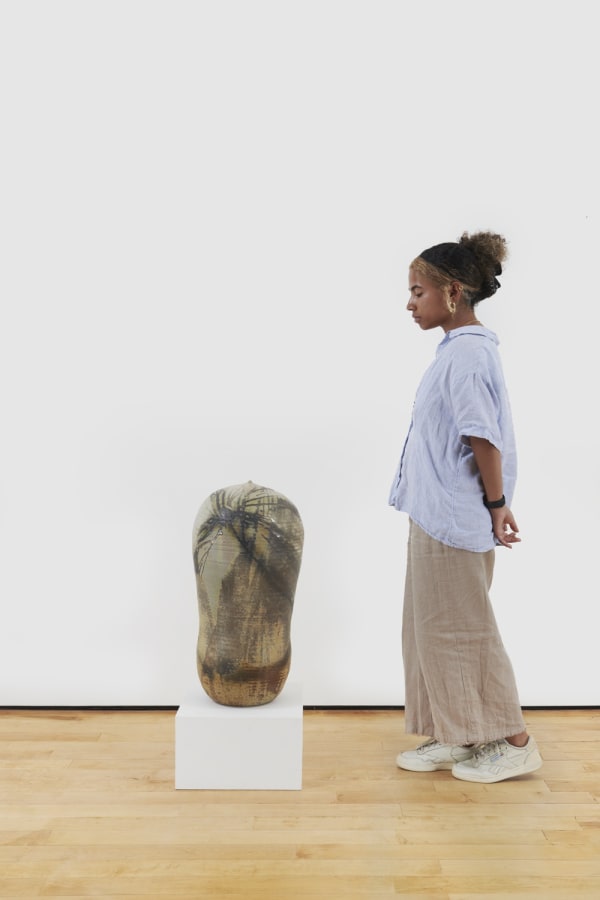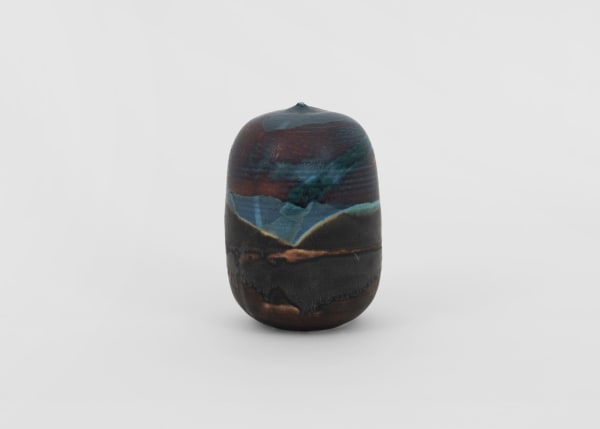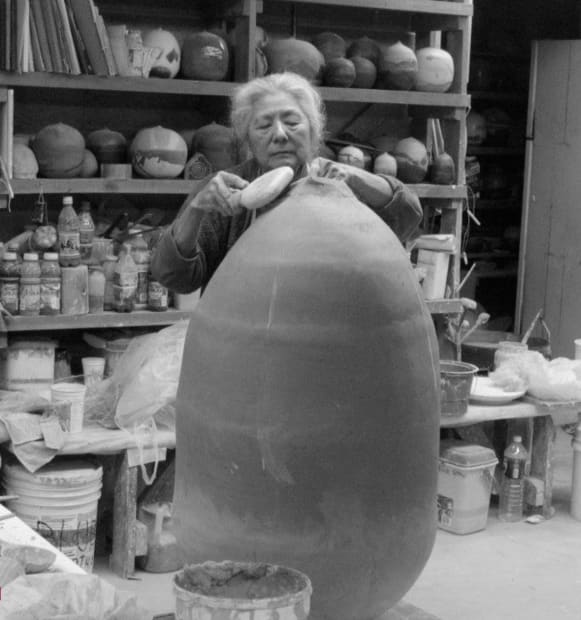-
-
For the 2022 edition of ADAA: The Art Show, James Cohan will present sculptures by the American master ceramicist Toshiko Takaezu (b. 1922, Pepeekeo, Hawaii - d. 2011, Honolulu, Hawaii). Over her five-decade career, Takaezu’s aesthetic approach was influenced by Abstract Expressionism and the traditions of East Asia, including ink painting and the Japanese tea ceremony. Her signature closed forms fuse these visual inspirations and demonstrate the artist’s process of abstraction, in which she experimented with gestural application of glazes, treating the vessel as a canvas in the round. Highlights from the presentation are included below.
-
-
Takaezu masterfully articulated her expansive circular “canvases” – scroll-like compositions, without beginning or end – with a broad vocabulary of splashing, brushwork, and pouring, employing oxides and glazes of her own devising. In some of her best works, veils of superimposed color create a sense of infinite depth, and seem to coalesce within the profundity of the pot. - Glenn Adamson
-

Toshiko throwing a closed form at the Penland School of Crafts, North Carolina. Photo credit: Evon Streetman. Courtesy of The Family of Toshiko Takaezu
-
Takaezu began working towards the closed form in the 1950s, experimenting with enclosing the interior volume of her vessels and leaving a small opening that allowed for gas to escape during firing. The act of closure rendered the vessels functionless, suggesting that they now inhabited the realm of sculpture. She continued to produce these forms well into the 1990s and 2000s, eventually at monumental scale. This presentation features sculptures as small as 5 inches and taller forms nearing 38 inches high.
-
Takaezu’s format allowed her to explore a wide range of surface effects: layering, veiling, and expressionist gestures in her application of glazes. She applied glaze onto the clay with a brush while also occasionally, in a controlled manner, dipping and pouring glaze to create dynamic surfaces. Her palette often references colors seen in nature – particularly from her native Hawaii – like ochre, black, white, brown, soft grays and varying shades of blue. Applications of yellow, pink, orange and greens were often atmospheric and sometimes suggestive of foggy landscapes and ink paintings.
-
-
...there is a sensuousness about her use of color…that catches the breath. She has a way of taking a color, brushing it softly across a surface, tipping it up suddenly and letting it slide crosswise, then stopping it just short of an unexpected rest…The sense of dynamics in Takaezu’s painting has something musical about it, as if glazes were to turn into melodies and silences. - Elizabeth Breckenridge
-

-
Takaezu evolved a discrete series of globular forms that she called Moons. From the early 70s on, these were formed from two halves in molds. Their surfaces may be smooth, shiny, or matte, often featuring a multitude of colored glazes. The full moon, Untitled (1990s) features washes of ochre, greens and browns and bold strokes of inky black glaze swooping over its curved surface. Her moons recall heavenly bodies and planetary forms.
-
I made some closed ceramic forms in 1965-66 and the surfaces reminded me of moonscapes, some of them stark naked… And I started making round pots. The moon shots were in the news then, but I would have done it anyway. I like the moon and I like round forms a lot. - Toshiko Takaezu
-
Occasionally, Takeazu veered from the wheel and built up vessels using molds, assembling them with her hands. She was never particularly concerned with symmetry and the hand-built forms in this presentation are examples of the artist embracing irregularity, even accentuating it through her glazing in Untitled, ca. 1990s. In Shiro Momo #2, ca. 1990, which she made after her mother’s passing, Takaezu deliberately rendered slits near the opening, granting an entry point into its hollow interior. Both of these forms have a natural connection to the earth in their coloration and their bodily shape.
-
-
-
CHECKLIST
-
 TOSHIKO TAKAEZU, Untitled, ca. 1990s
TOSHIKO TAKAEZU, Untitled, ca. 1990s -
 TOSHIKO TAKAEZU, Untitled, ca. 1990s
TOSHIKO TAKAEZU, Untitled, ca. 1990s -
 TOSHIKO TAKAEZU, Shiro Momo #2, ca. 1990
TOSHIKO TAKAEZU, Shiro Momo #2, ca. 1990 -
 TOSHIKO TAKAEZU, Untitled, ca. 1990s
TOSHIKO TAKAEZU, Untitled, ca. 1990s
-
 TOSHIKO TAKAEZU, Wildweed, ca. 1990s
TOSHIKO TAKAEZU, Wildweed, ca. 1990s -
 TOSHIKO TAKAEZU, Untitled, 2009
TOSHIKO TAKAEZU, Untitled, 2009 -
 TOSHIKO TAKAEZU, Untitled, ca. 1990s
TOSHIKO TAKAEZU, Untitled, ca. 1990s -
 TOSHIKO TAKAEZU, Untitled, 2009
TOSHIKO TAKAEZU, Untitled, 2009
-
 TOSHIKO TAKAEZU, Untitled, ca. 1990s
TOSHIKO TAKAEZU, Untitled, ca. 1990s -
 TOSHIKO TAKAEZU, Closed Form, ca.1980s
TOSHIKO TAKAEZU, Closed Form, ca.1980s -
 TOSHIKO TAKAEZU, Untitled, ca. 1990s
TOSHIKO TAKAEZU, Untitled, ca. 1990s -
 TOSHIKO TAKAEZU, Untitled, ca. 1990s
TOSHIKO TAKAEZU, Untitled, ca. 1990s
-
 TOSHIKO TAKAEZU, Closed Form (Ocean Edge), ca. 1995
TOSHIKO TAKAEZU, Closed Form (Ocean Edge), ca. 1995 -
 TOSHIKO TAKAEZU, Closed Form (Ocean Edge), ca. 1994
TOSHIKO TAKAEZU, Closed Form (Ocean Edge), ca. 1994 -
 TOSHIKO TAKAEZU, Untitled, ca. 1980s
TOSHIKO TAKAEZU, Untitled, ca. 1980s -
 TOSHIKO TAKAEZU, Untitled, ca. 1990s
TOSHIKO TAKAEZU, Untitled, ca. 1990s
-
-
Born in Pepeekeo, Hawaii in 1922 to Japanese immigrant parents, Takaezu studied ceramics first with Claude Horan, the founder of the ceramics program at the University of Hawaii, and later with the influential Finnish-American ceramicist Maija Grotell at the Cranbrook Academy of Art in Michigan. Takaezu was a devoted maker and art educator, teaching first at the Cleveland Institute of Art and then at Princeton University, until her retirement in 1992. She lived and worked on a lush property in rural New Jersey, establishing a steady studio practice and firing her work on site with the aid of apprentices. Takaezu passed away in Honolulu on March 9, 2011.
Throughout the artist’s lifetime, her work was exhibited widely in the United States and Japan, including a solo exhibition at the Philadelphia Museum of Art (2004) and a retrospective at the National Museum of Modern Art in Kyoto, Japan (1995). Takaezu was the recipient of a McInerny Foundation Grant (1952), Tiffany Foundation Grant (1964), National Endowment for the Arts Fellowship (1980), among others. Takaezu received honorary doctorate degrees from Lewis and Clark College (1987), Moore College of Art and Design (1992), University of Hawaii (1993), Princeton University (1996), and Skidmore College (2004). Her work is represented in collections including the Art Institute of Chicago, DeYoung/Fine Arts Museum of San Francisco, Honolulu Museum of Art, Los Angeles County Museum of Art, The Metropolitan Museum of Art, New York, Museum of Fine Arts, Boston, and the Smithsonian American Art Museum.
Recent exhibitions include the 2022 edition of the Venice Biennale, The Milk of Dreams curated by Cecilia Alemani. In February 2024, The Isamu Noguchi Foundation and Garden Museum will host the first touring retrospective of Takaezu’s work in twenty years. The exhibition will be accompanied by a new monograph published in association with Yale University Press and will travel to the Cranbrook Art Museum (2024–25), the Museum of Fine Arts, Houston (2025), and the Honolulu Museum of Art (2026). A complementary large-scale installation will open at the Museum of Fine Arts, Boston in October 2023. -
SOURCES:
Glenn Adamson, “Painting In The Dark”, curatorial essay published on the occasion of Painting in the Dark at James Cohan, 52 Walker Street, New York, NY, June 23 - August 5, 2022.
Elizabeth Breckenridge, professor of art history, Cleveland Institute of Art, “Form and Fiber: Takaezu & Tawney,” Oct 14- Nov. , 1979, publication unknown, p.42.
Peter Held, “In the language of silence, The Art of Toshiko Takaezu” 2010, published by The Toshiko Takaezu Foundation, New York.
John Perreault, “Toshiko Takaezu: Truth In Clay,” from Toshiko Takaezu: Heaven and Earth published on the occasion of the exhibition of her multipart installation Star Series, at the Racine Art Museum, Racine, Wisconsin, from September 2005 - January 8, 2006.
Toshiko Takaezu Foundation - https://www.toshikotakaezufoundation.org
Toshiko Takaezu at ADAA: The Art Show: BOOTH A1 | PARK AVENUE ARMORY
Past viewing_room

























